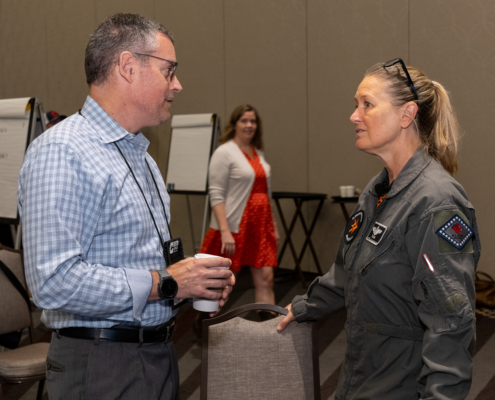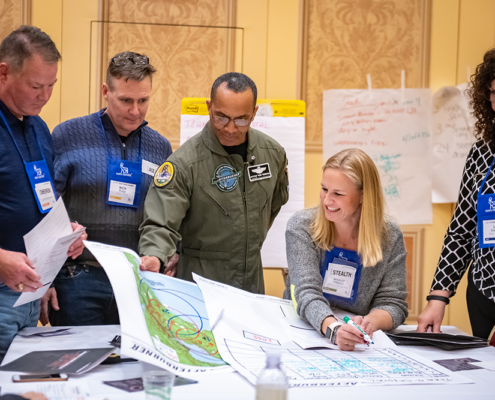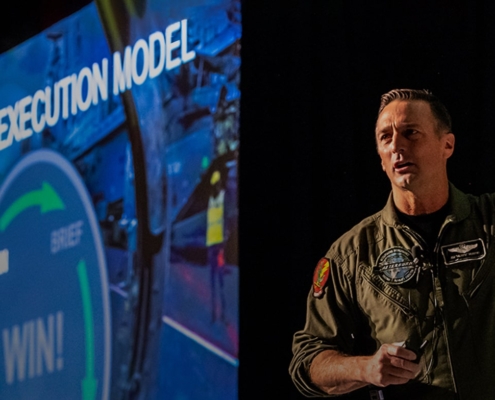 https://www.afterburner.com/wp-content/uploads/2024/11/High-Impact-Leader-Crete2024Summit-677-scaled.jpg
1707
2560
Ansley Anchors
/wp-content/uploads/2024/07/Afterburner-Logo-Resize-Fullcolor-300x93.png
Ansley Anchors2024-11-05 10:52:592024-11-20 14:55:53The Top 5 Attributes of a High-Impact Leader
https://www.afterburner.com/wp-content/uploads/2024/11/High-Impact-Leader-Crete2024Summit-677-scaled.jpg
1707
2560
Ansley Anchors
/wp-content/uploads/2024/07/Afterburner-Logo-Resize-Fullcolor-300x93.png
Ansley Anchors2024-11-05 10:52:592024-11-20 14:55:53The Top 5 Attributes of a High-Impact Leader
Building High-Performing Teams Takes Insight
There’s no doubt debriefing is valuable, but how many groups are truly high-performing teams that take the time to debrief their missions, analyzing their execution in order to accelerate wins and minimize losses? The answer shouldn’t surprise you – very few.
It takes a strong team and a mission-first mentality to hold a nameless, rankless performance analysis but once your team experiences the impact of Lessons Learned on mission results, they’ll never look back.
Because knowledge sharing is critical to accelerated and continuous learning, we’re here to share how our clients have leveraged Flawless ExecutionSM (FLEX) to tip the scale of success on game-changing missions. Now is the time to learn from mistakes, repeat successes and drive execution forward to achieve your potential.
Which Lessons Learned will you use in going forward?
Accelerate Your Team Performance with These Lessons Learned
| KEEPING YOUR MISSION ON TRACK
Situational Awareness:
A standard mission plan is built from the collaborative effort of numerous people, each one responsible for delivering results on time and on target. And because every mission should be aligned to and directly support organizational initiatives, Flawless Execution should be the ultimate objective.
Scope creep is a very real challenge, so when a top ten global software company needed to meet an aggressive timeline for a product launch earlier this year, they included weekly X-GapsSM into each of the tactical Mission plans that supported the strategic launch campaign. Doing so enabled several large, dispersed teams to increase transparency, drive accountability and improve mutual support for successful—and early—mission completions.
Lessons Learned:
► Clearly outline the minimum contribution required of team members and request a verbal commitment to those expectations prior to finalizing your team roster.
“We had a mission involving eight teams across three business units and knew open collaboration would be critical… We learned our teams need to be available for planning in an open forum and have an understanding of expectations before the mission began.”
► Schedule regular X-Gaps into the Mission Course of Action (COA) to mitigate contingencies, capitalize on opportunities that arise and agilely adjust during the Execution phase.
“The X-Gap meeting eliminated confusion and provided clarity…(They) incentivized people to execute because they don’t want to let the team down. Now we have a framework, where before there was nothing.”
► X-Gaps are for addressing change quickly without debate to maintain Execution Rhythm. When an X-Gap uncovers items that require further discussion, keep only those required afterward to quickly collaborate, decide and pivot while freeing up remaining mission team members’ time.
“The meetings were brief and concise, we did not spend time in the X-Gap session deciding about an action item.”
| LOSE MOMENTUM, LOSE THE FIGHT
Situational Awareness:
A slow, insidious decline into complacency negatively impacts morale as well as mission success. Often caused by Task SaturationSM and the ambiguity of new and changing challenges, it’s difficult to keep momentum high during long-term missions. A team of mid-level leaders used these Lessons Learned to establish motivation early in a year-long strategic campaign…
Lessons Learned:
► Limit tactical Missions to 90 days or less to build-in short-term wins that keep morale high and build momentum during long-term projects.
“At first, people thought there was no way we were going to complete this Mission… Through this process, there is now a belief that this project can actually be done.”
► Emphasize the “High Note” of your STEALTH DebriefSM, regardless of the outcome, to rally your team and set the tone for the next mission.
“We thought this was an unachievable mission…Our task was now: how do we leverage this success?”
| LEADERSHIP AS AN ACCOUNTABILITY TOOL
Situational Awareness:
Effective leadership is a fundamental component in building cultures of accountability, so if your leadership development efforts are lacking, you likely have accountability challenges, too. For a team of regional sales managers tasked with planning and executing a market penetration plan, the correlation between leadership and accountability was debriefed in the first of five missions.
Lessons Learned:
► Clearly define and regularly update the role responsibilities of the Mission Ace (i.e. team leader) to ensure Aces are prepared to develop individuals and enable mission achievement.
“We learned to make sure our Ace held individual members of teams accountable…If we have single points of accountability when planning, it’s easier for the Ace to see gaps during execution.”
► The Mission Ace should drive strategically aligned action by having team members regularly reference their Attitude Indicators, providing mutual support in identified areas.
“We have to be more deliberate with dates assigned to team members, and make sure our champion is providing resources and removing the obstacles that stand in our way.”
| REDUNDANT EFFORT & DECREASED EFFICIENCY
Situational Awareness:
Great work doesn’t mean much if it’s the wrong work. This was a critical Lesson Learned for a team of front-line HSE managers who experienced significant time and resource losses when they failed to confirm the Leader’s Intent for the mission and garner stakeholder buy-in prior to planning their mission.
“Several members were representing their department during the planning session, but they didn’t have the power to support the plan,” said one team member during a debrief. “They each had to return to their leaders and ask for approval that they didn’t always receive.”
Lessons Learned:
► Establish team member role criteria for every mission and confirm that each individual meets that criteria prior to planning in order to avoid delays and redundant effort.
“Each person at the planning session must be a subject matter expert and empowered to make decisions…We’re going to incorporate that requirement into all of our future planning sessions.”
► The team leader should prepare the team for an efficient planning session by distributing important information or required knowledge prior to the session.
“Valuable planning time was lost educating folks on Mission details…(We learned) the Ace should send a read-ahead guide before the session or even split it up into two sessions for particularly complex missions.”
LESSONS LEARNED
Each took the time to analyze their team performance, identify the root-causes of wins and losses to gather Lessons Learned for accelerated performance improvement in their next missions. Simple, right? It is, and your performance can show the same results by integrating nameless, rankless STEALTH Debriefs into your day-to-day operations.
So, what’s your most important Lesson Learned? That you can’t build a high-performing team without Lessons Learned. And you can’t afford to execute another mission without Lessons Learned either.
Share This Post
More Like This
 https://www.afterburner.com/wp-content/uploads/2024/11/High-Impact-Leader-Crete2024Summit-677-scaled.jpg
1707
2560
Ansley Anchors
/wp-content/uploads/2024/07/Afterburner-Logo-Resize-Fullcolor-300x93.png
Ansley Anchors2024-11-05 10:52:592024-11-20 14:55:53The Top 5 Attributes of a High-Impact Leader
https://www.afterburner.com/wp-content/uploads/2024/11/High-Impact-Leader-Crete2024Summit-677-scaled.jpg
1707
2560
Ansley Anchors
/wp-content/uploads/2024/07/Afterburner-Logo-Resize-Fullcolor-300x93.png
Ansley Anchors2024-11-05 10:52:592024-11-20 14:55:53The Top 5 Attributes of a High-Impact Leader https://www.afterburner.com/wp-content/uploads/2024/09/fighter-jet-performing-quick-ariel-maneuver.jpeg
1280
1920
Nate Riggins
/wp-content/uploads/2024/07/Afterburner-Logo-Resize-Fullcolor-300x93.png
Nate Riggins2024-01-02 19:53:032024-11-20 14:55:544 Ways to Boost Your Team’s Morale and Hit Your Revenue Targets
https://www.afterburner.com/wp-content/uploads/2024/09/fighter-jet-performing-quick-ariel-maneuver.jpeg
1280
1920
Nate Riggins
/wp-content/uploads/2024/07/Afterburner-Logo-Resize-Fullcolor-300x93.png
Nate Riggins2024-01-02 19:53:032024-11-20 14:55:544 Ways to Boost Your Team’s Morale and Hit Your Revenue Targets https://www.afterburner.com/wp-content/uploads/2024/09/Group_Meeting_2-1.jpeg
1707
2560
Nate Riggins
/wp-content/uploads/2024/07/Afterburner-Logo-Resize-Fullcolor-300x93.png
Nate Riggins2024-01-02 18:26:092024-11-20 14:55:54Fueling Business Agility: The Strategic Pivot
https://www.afterburner.com/wp-content/uploads/2024/09/Group_Meeting_2-1.jpeg
1707
2560
Nate Riggins
/wp-content/uploads/2024/07/Afterburner-Logo-Resize-Fullcolor-300x93.png
Nate Riggins2024-01-02 18:26:092024-11-20 14:55:54Fueling Business Agility: The Strategic Pivot https://www.afterburner.com/wp-content/uploads/2024/09/airborn-fighter-jet-using-afterburners-1.jpeg
1080
1920
Nate Riggins
/wp-content/uploads/2024/07/Afterburner-Logo-Resize-Fullcolor-300x93.png
Nate Riggins2024-01-02 18:19:252024-11-20 14:55:55Combat Distractions and Boost Your Revenue – Fighter Pilot-Style
https://www.afterburner.com/wp-content/uploads/2024/09/airborn-fighter-jet-using-afterburners-1.jpeg
1080
1920
Nate Riggins
/wp-content/uploads/2024/07/Afterburner-Logo-Resize-Fullcolor-300x93.png
Nate Riggins2024-01-02 18:19:252024-11-20 14:55:55Combat Distractions and Boost Your Revenue – Fighter Pilot-Style https://www.afterburner.com/wp-content/uploads/2024/09/jamie-street-_94HLr_QXo8-unsplash-1.jpeg
1380
2048
Nate Riggins
/wp-content/uploads/2024/07/Afterburner-Logo-Resize-Fullcolor-300x93.png
Nate Riggins2024-01-02 15:02:302024-11-20 14:55:553 Steps New Leaders Must Include in Their Strategic Planning Process
https://www.afterburner.com/wp-content/uploads/2024/09/jamie-street-_94HLr_QXo8-unsplash-1.jpeg
1380
2048
Nate Riggins
/wp-content/uploads/2024/07/Afterburner-Logo-Resize-Fullcolor-300x93.png
Nate Riggins2024-01-02 15:02:302024-11-20 14:55:553 Steps New Leaders Must Include in Their Strategic Planning Process https://www.afterburner.com/wp-content/uploads/2024/09/team-looking-at-map-to-focus-on-improving-teamwork-in-the-workplace-1.png
667
1000
Nate Riggins
/wp-content/uploads/2024/07/Afterburner-Logo-Resize-Fullcolor-300x93.png
Nate Riggins2024-01-02 03:00:272024-11-20 14:55:554 Tips for Improving Teamwork in the Workplace
https://www.afterburner.com/wp-content/uploads/2024/09/team-looking-at-map-to-focus-on-improving-teamwork-in-the-workplace-1.png
667
1000
Nate Riggins
/wp-content/uploads/2024/07/Afterburner-Logo-Resize-Fullcolor-300x93.png
Nate Riggins2024-01-02 03:00:272024-11-20 14:55:554 Tips for Improving Teamwork in the Workplace https://www.afterburner.com/wp-content/uploads/2024/09/planning-1.jpeg
933
1400
Nate Riggins
/wp-content/uploads/2024/07/Afterburner-Logo-Resize-Fullcolor-300x93.png
Nate Riggins2023-05-02 20:23:162024-11-20 14:55:58Using Brain Chemistry For Building High-Performance Teams
https://www.afterburner.com/wp-content/uploads/2024/09/planning-1.jpeg
933
1400
Nate Riggins
/wp-content/uploads/2024/07/Afterburner-Logo-Resize-Fullcolor-300x93.png
Nate Riggins2023-05-02 20:23:162024-11-20 14:55:58Using Brain Chemistry For Building High-Performance Teams https://www.afterburner.com/wp-content/uploads/2024/09/afterburner-banner-image-ceo-jim-murphy-giving-a-presentation_crop-1.jpeg
784
1920
Nate Riggins
/wp-content/uploads/2024/07/Afterburner-Logo-Resize-Fullcolor-300x93.png
Nate Riggins2022-11-14 21:30:142024-11-20 14:55:58What If Your Teams Were Truly High Performing?
https://www.afterburner.com/wp-content/uploads/2024/09/afterburner-banner-image-ceo-jim-murphy-giving-a-presentation_crop-1.jpeg
784
1920
Nate Riggins
/wp-content/uploads/2024/07/Afterburner-Logo-Resize-Fullcolor-300x93.png
Nate Riggins2022-11-14 21:30:142024-11-20 14:55:58What If Your Teams Were Truly High Performing?
Top Three Threats to Employee Morale in Today’s Economy
Business Culture, Leadership, Motivation, Team BuildingAbout Us
Building Strong Teams Through the Guidance of Fighter Pilot Keynote Speakers.

